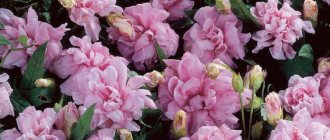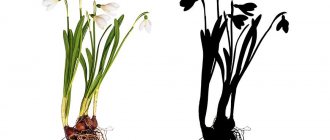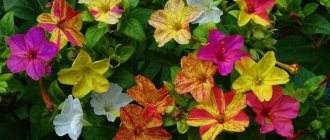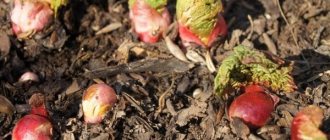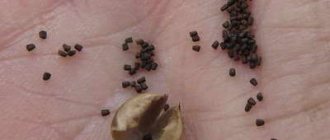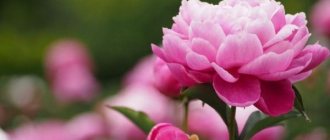Collection of delphinium seeds
You can collect seeds from any healthy plant. If the variety is unknown to you, but you really like the flowers, try growing them. Hybrids produce good seeds, but the plant will not repeat itself. There is a splitting of signs. You will get two varieties at once; they may bear little resemblance to their ancestor. Varieties without the F1 designation can be safely propagated by seeds, although there is a risk of cross-pollination by insects if other varieties grow very close by.
After flowering, seed boxes appear on the bushes. At first they are green, a little later they turn brown. From now on you need to watch carefully. As soon as the boxes begin to dry, they need to be cut off and laid out on paper in a dry place. Do not collect seeds after watering, rain or heavy fog. Separate the seeds from the partitions and flaps. Dry them for a couple of days, then put them in a paper bag in the refrigerator. Do not leave on a shelf or in a closet. Germination rate drops very quickly in warm conditions.
Description
Delphinium belongs to the buttercup family.
The unopened flower buds resemble the head of a dolphin, hence the name of the plant. There is another version of the appearance of the name. In the vicinity of the Greek city of Delphi, located at the base of Mount Parnassus, a huge number of these flowers grew. The city was famous for the temple of Apollo. This is how the culture was named in honor of the city and the temple - the flower of Delphic Apollo. The natural habitat is quite wide - China, Siberia, Mongolia, Europe. The plant feels comfortable in forest clearings and outskirts, along streams, and in mountain meadows.
A rigid, erect stem emerges from the thick fibrous roots of the delphinium. It does not branch and can be either pubescent or non-pubescent. The leaves are attached to the stem using a petiole, located oppositely. They are quite large, with a jagged or smooth edge, finger-pinnate in shape.
A special decoration are flowers of various colors - blue, white, pink, purple. They can also be two-tone, soft pastel colors or bright “screaming” shades.
The flowers are collected in one pyramidal inflorescence. Its length can reach 100 cm. The diameter of an individual flower ranges from 4 to 6 cm. Spur flowers can be simple or double, depending on the species. Flowering occurs in June-July. Fragrant flowers attract many insects.
Delphiniums are not suitable for food as they are poisonous. The plant is also dangerous for herbivores.
Sowing time
The optimal time for sowing delphinium seedlings is February. By the time of planting in open ground, the plants will be quite strong, many of them will be able to bloom in the first year. This crop is not at all afraid of frost, but there is no need to rush into planting. In warm conditions, seedlings develop faster.
Sowing in open ground can be done in the fall before winter and with the onset of the first warm days. However, this method is more suitable for unpretentious varieties and only if you have a lot of seeds. In a snowless winter or severe spring frosts, seeds or seedlings may die. But there is also a plus in this. If the plants have sprouted well enough, you can select only the strongest specimens. Those that can withstand adverse conditions will be best adapted to your climate.
Main types and varieties with photos and names
Delphiniums are classified as annuals and perennials. The most popular annual plants are Ajax delphinium and field delphinium.
Delphinium Consolida
This flower is different in that it can reach 2 meters in height. The inflorescences consist of double or simple flowers, which can be colored white, blue, pink, or lilac. Cultivated since 1572. The most beautiful varieties are considered: Frosted Sky - its blue flowers have a white central part, Qis Rose - light pink flowers, and Qis Dark Blue - with dark blue flowers. Flowering begins in the first days of summer and continues until the onset of autumn.
Delphinium of Ajax
Such a hybrid plant was created by crossing the Eastern delphinium and the Doubtful delphinium, and he received their best qualities from them. The height of the shoots varies from 40 to 100 centimeters. The heavily dissected leaf blades are practically sessile. The length of the spike-shaped inflorescences reaches 30 centimeters; the flowers can be painted in various colors: red, pink, white, purple, blue, and blue. There are varieties with densely double flowers. There are dwarf varieties, for example, Dwarf Hyacinth-flowered - the bush reaches 30 centimeters in height and has double flowers of pink, white, purple, and crimson. Flowering of this variety begins in July and continues until frost.
Perennial delphiniums began to be cultivated in the 19th century. Breeders, crossing the first perennial plants Delphinium Elatum and Delphinium Grandiflora, obtained several of the first hybrid plants, namely: Delphinium Barlowii, Delphinium Formosum and Delphinium belladonna. Later, the French breeder V. Lemoine developed perennial varieties with double flowers of blue, purple, and lavender colors, and they were called “hybrid” (Delphinium hybridum) or beautiful (Delphinium Ornatum), and after some time they began to be called “cultivated” (Delphinium cultorum). Today, perennial delphinium flowers can be painted in a wide variety of color shades, of which there are about 800. There are low-growing, tall and medium-growing varieties, the flowers of which can be super-double, double, simple and semi-double, and their diameter can be 2–9 centimeters .
Perennial hybrid plants are divided into groups according to their place of origin. The most popular delphiniums are New Zealand (New Millennium Delphiniums, or New Zealand Hybrids), Scottish (F1 hybrids) and Mafin hybrids, named after the Mafino state farm. Each group has its own distinctive features and positive aspects. For example, Marfinskie have a very beautiful appearance, and are also distinguished by excellent frost resistance; they also have fairly large semi-double flowers with eyes painted in a rich contrasting color (varieties: “Morpheus”, “Pink Sunset”, “Blue Lace”, “ Spring snow"). However, the seeds are not suitable for growing Marfin delphinium, because in this case the varietal characteristics are not preserved.
More recently, a New Zealand group was formed. The plants included in it are quite tall and can reach a height of about 220 centimeters. They are quite large (diameter approximately 7–9 centimeters) terry or semi-double. There are types with corrugated petals. Such hybrid plants are frost-resistant, not susceptible to disease, and they are also durable and ideal for cutting. In this regard, these delphiniums are currently the most popular among gardeners. If you sell fresh flowers, then New Zealand delphiniums can bring good profits. The most popular varieties: Sunny Skies, Green Twist, Pagan Purples, Blue Lace, Sweethearts.
T. Coakley became the creator of hybrid Scottish perennial delphiniums. These hybrid plants have double and super-double flowers with very dense inflorescences. In some cases, it grows up to 58 petals on one flower. The bush has a height of about 110–150 centimeters, while the length of the inflorescence is 80 centimeters. Flowers can be painted in a wide variety of colors. They are durable, easy to care for and, when grown from seeds, retain the characteristics of the parent plant. The most popular varieties are: Morning Sunrise, Blueberry Pie, Moon Light, Sweet Sensation, Crystal Delight and Deepest Pink.
The best varieties of perennial Delphinium in the garden
Ideal soil for delphinium
If it is not possible to purchase neutral soil for cacti or succulents, buy soil for seedlings. Delphinium does not tolerate acidic soil; preparing neutral, slightly acidic or slightly alkaline soil yourself is difficult, but quite possible. To do this, use a measuring container. Add one cup each of peat, turf soil, humus and half a cup of coarse sand. Mix everything until smooth. If the soil is too heavy, add chopped straw or perlite.
Stratification of delphinium seeds
Stratification significantly increases seed germination and makes seedlings healthier and more stress-resistant. Seeds should be sown in a shallow seedling box or in peat tablets, moisten the soil, close the container tightly, wrap it in plastic so that the moisture does not evaporate and put it in the refrigerator. Of course, a veranda or balcony is suitable, but there may be temperature changes there that can have a detrimental effect on germination. Seeds may die at temperatures below -5 degrees.
After 10-12 days you need to inspect the containers. The fact is that seeds can hatch even in the refrigerator. If you see shoots, it’s time to put them in a lighted place. A window sill where the temperature does not exceed +20 degrees is well suited.
Caring for delphinium seedlings
Lighting is necessary even on a south window. In February, daylight hours are too short for delphinium. Water at the roots as needed; the soil on the surface should always be moist. Do not spray plants.
At the stage of two true leaves, seedlings must be picked. Plant those grown in peat tablets in containers. To ensure that the plants are well developed, 300 ml containers are sufficient. When planting, bury the young shoots down to the base of the leaf growth. In mid-to-late May, seedlings should be planted in a permanent place; a week before, feed them with Agricola or other soluble fertilizer. In order not to make a mistake with the dosage, the easiest way to do this is with a syringe. Be sure to combine fertilizing with watering to evenly distribute nutrients in the soil. Do not forget to sunbathe the plants, gradually increasing their duration, so that the delphiniums do not experience stress during transplantation.
Delphinium after flowering
When the leaves of a faded plant dry out, the shoots should be cut to a height of 30–40 centimeters from the ground surface. In this case, it is recommended to coat the top of the hollow shoot with clay, which will prevent liquid from entering it and the formation of rot in the root system. Almost all types of delphinium are frost-resistant (both young and adult specimens). If the winter period is little snow and frosty, then the delphinium should be covered with straw or spruce branches. Delphinium can die only from frequent and sudden changes in temperature, as high humidity appears and it rots. To prevent stagnation of water in the soil, pour ½ of a bucket of sand into the bottom of the planting hole during planting.
Planting delphinium in open ground
Choose a place where nothing will disturb the plant in the coming years. Add organic fertilizer to more than just the holes. It is better to fertilize the entire bed to improve the structure and nutritional value of the soil. Handle the seedlings while preserving the earthen clod. At first, it is necessary to diffuse the sunlight. An agrofibre shelter is suitable for this. After 3-5 days the plants adapt; after lunch, remove the cover.
Already in August, most of the bushes will delight you with gorgeous candles of flowers, and a year later you can admire full bloom.
Delphinium is one of the most magnificent perennials; be sure to place it on your site. Author of the article: Oksana Artemenko
Use in landscape design
Delphinium is used in cultivation to create bright accents, and tall varieties in group linear plantings can serve for zoning an area. Use it in the background of a flower bed, mixborder or edging. Lush, dense inflorescences of decorative varieties can be combined to create a variety of compositions.
In terms of flowering time, delphiniums come immediately after irises and peonies, which must be taken into account when creating a flower bed with continuous flowering. Roses, lilies, phlox, daisies and carnations can provide company in a flower garden. Large inflorescences are suitable for cutting and making bouquet arrangements.



